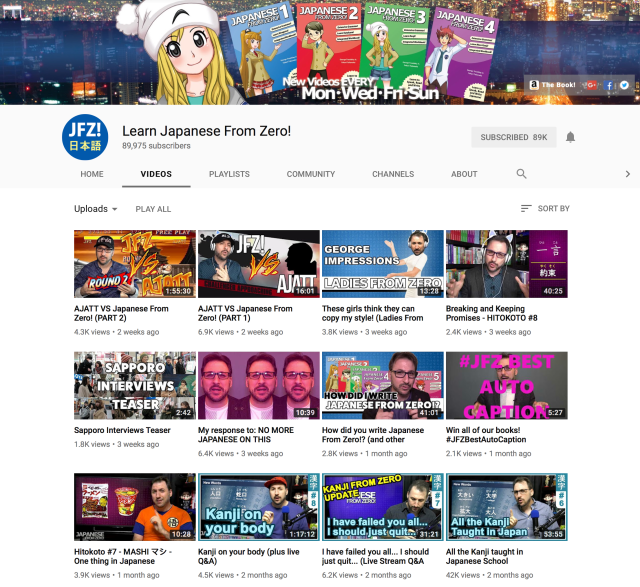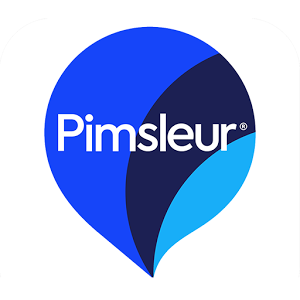YouTube:
You tube is probably now one of the best places to go for free language learning resources. If you are stuck on a grammar point, having difficulty with pronunciation, or want to hear how the language is used in a real world setting, YouTube has it all. Below are some channels that you may find useful for learning Japanese.
Another channel from the language pod 101 series. Japanese Pod 101 presents small, bite sized lessons that are useful and fun. This is a great channel if you are looking for a quick clarification on a particular topic or some interesting cultural points. It is updated often and when used in conjunction with their podcasts it is a sure fire way to boost your Japanese learning.

This is the companion channel to the book series “Japanese from Zero”. The host, George is a native English speaker that has learned to speak Japanese at a very high level. This allows him to present content from the perspective of an English speaker learning Japanese which means that he has an awareness for the most troublesome aspects of the language. He has a lot of videos covering a wide array of topics from grammar, pronunciation, reading, kanji, and culture. This channel can be used on its own to reference or used in conjunction with the books. Either way it is definitely worth checking out.
Baka loosely translates to “fool” or “idiot” in Japanese and the channel focuses on using anime to explain colloquial Japanese. If you are an anime or manga fan this you will surely find this channel entertaining and informative. Typically they select one word or phrase from a popular anime and explore it’s meaning and use. The videos are well done but they haven’t been producing new content as often recently.

Misa produces some great videos with simple explanations of Japanese grammar and vocabulary. She simply explains some of the most common hang-ups with the Japanese language and content is still being released fairly regularly. Misa provides plenty of example sentences and speaks slow and clear so that you can easily follow along. If you are looking for a little break from the language she also puts out some videos on culture and life in Japan.

Yuu Asakura is a Japanese American who has been putting out some pretty helpful language learning videos. She discusses some common grammar points and also provides phrases and vocabulary for day-to-day scenarios. The focus of Yuu’s channel isn’t language learning so there is a lot of other content to be found, but if you are looking for some clarification or just a different explanation on some of the more common topics you may find her videos helpful.

 Pimsleur audio course have been around for many years making them one of the more trusted and reputable audio courses available. Their systematic approach and gradual introduction of vocabulary and concepts are quite effective for a lot of people. Audio courses are a great supplement to your language learning routine as it affords you the ability to study almost anywhere. Long commutes to work in the care or on the train can be filled with audio lessons to help you learn and improve quickly. Although some courses can be a bit expensive, you can often find introductory courses via CD on amazon for as little as $50. Also check your local library to see if they stock a course for you to borrow. The Pimsleur method uses science and research to introduce and review concepts at appropriate times to ensure that what you learn is transferred to your long term memory allowing you to progress at a steady rate.
Pimsleur audio course have been around for many years making them one of the more trusted and reputable audio courses available. Their systematic approach and gradual introduction of vocabulary and concepts are quite effective for a lot of people. Audio courses are a great supplement to your language learning routine as it affords you the ability to study almost anywhere. Long commutes to work in the care or on the train can be filled with audio lessons to help you learn and improve quickly. Although some courses can be a bit expensive, you can often find introductory courses via CD on amazon for as little as $50. Also check your local library to see if they stock a course for you to borrow. The Pimsleur method uses science and research to introduce and review concepts at appropriate times to ensure that what you learn is transferred to your long term memory allowing you to progress at a steady rate.
 The Michel Thomas series is another highly respected audio course that offers a range of products for each level. Although they only offer their courses in about 12 languages, they present the information in a unique way that many find very useful. The Michel Thomas method puts you, as a third student, in an imaginary class. You will learn alongside two other students who will pause and make mistakes at a lot of the same points you will. What makes this particularly useful is that you have the ability to participate in real time with the speakers as part of a group. This helps your brain assimilate information as part of an experience and not just simply listening to audio. We are more likely to remember pieces of information if our brain has context to store it in. The Michel Thomas courses do an excellent job of gradually introducing and reintroducing these pieces of information in a contextually relevant manner. Some of the courses can be expensive, but again, check your local library or used bookstore for copies.
The Michel Thomas series is another highly respected audio course that offers a range of products for each level. Although they only offer their courses in about 12 languages, they present the information in a unique way that many find very useful. The Michel Thomas method puts you, as a third student, in an imaginary class. You will learn alongside two other students who will pause and make mistakes at a lot of the same points you will. What makes this particularly useful is that you have the ability to participate in real time with the speakers as part of a group. This helps your brain assimilate information as part of an experience and not just simply listening to audio. We are more likely to remember pieces of information if our brain has context to store it in. The Michel Thomas courses do an excellent job of gradually introducing and reintroducing these pieces of information in a contextually relevant manner. Some of the courses can be expensive, but again, check your local library or used bookstore for copies.
Podcasts:
Podcasts are an amazing way to help you learn a language. You can listen to them anywhere and they help you familiarise yourself with the sounds, tones, and rhythm of the language. Additionally you can often learn about current events, cultural points and idioms and expressions that you can’t get from audio courses. If you have some knowledge of a language already you can quickly acquire new vocabulary and grammar points and if you have no knowledge of a language, you can often reduce the speed of the podcast to hear clearly the pronunciation of each word. Be patient and with time you will be surprised on how much you understand!
| News in Slow Japanese | Learn Japanese Pod |
|---|---|
| NHK Radio | Bilingual News |
| Japanese Pod 101 | Fun Japanese Listening |